Chapter 1: No peace
BUNIA, Democratic Republic Congo —
It’s the evening before Easter when I meet them outside the Mudzi Maria Health Center. The sky is shifting from ochre to lavender and a choir’s voices soar from the nearby Catholic cathedral. For roughly the next half hour, the faithful offer up the triple chant of “Alleluia, a-llelu-ya, a-leh-heh-luuu-uuu-yah” — ancient argot for “Praise the Lord.”
Across from me sit three generations of women. Jesinne Dhewedza is the oldest, and like many in the region from her generation, she has no idea how old she actually is. Dhewedza doesn’t — maybe can’t — say what the men with machetes who fell upon her village late one night did to her, but her wizened hands tell part of the story. Two weeks ago, she had 10 fingers. Now she has six.
Praise the Lord.
Irene Mave is the youngest of the three. She’s wearing a striped polo shirt, a striped skirt, and an almost vacant stare. She knows how old she is. Before the attack, she could have held up six fingers, one for each year of her life in Logo Takpa, a farming village where the roofs are made of thatch. She can’t do that anymore. Two weeks ago, the men with machetes took her right arm.
Praise the Lord.
The third woman is Marie Dz’dza, Dhewedza’s daughter and Irene Mave’s aunt. Her hair is close-cropped, her frame slender and willowy. Plastic rosary beads the color of a robin’s egg hang around her neck. Two weeks ago, she had five children. Now, because of the men with machetes, she has four. Two weeks ago, she was a farmer, coaxing food from the soil. She harvested manioc with her two calloused hands. The men with machetes took those, too.
Praise the Lord.
The mysterious campaign of violence that swept through Djugu territory in the Democratic Republic of Congo’s Ituri province, affecting hundreds of thousands of the area’s people, began last December. The wave of terror crested in late February and early March as village after village — sometimes more than one per day — came under attack by men armed with pangas, axes, bows and arrows, and spears. In all, about 120 communities were attacked, according to the United Nations. Hundreds were killed and thousands of homes were destroyed.
There are many contending theories about the sudden surge in violence, but its outcome was unmistakable: an ethnic cleansing campaign was underway. Ituri’s minority ethnic group, the Hema, were driven from their homes by armed men — some of them their neighbors — mostly from the Lendu community. The destruction was so widespread that it could be seen from outer space and so merciless that some in the region worried the Hema weren’t just being driven from their homeland but being obliterated as a people. “This may be genocide,” Hadji Ruhingwa Bamaraki, president of the Hema community’s cultural association, told me at the time.
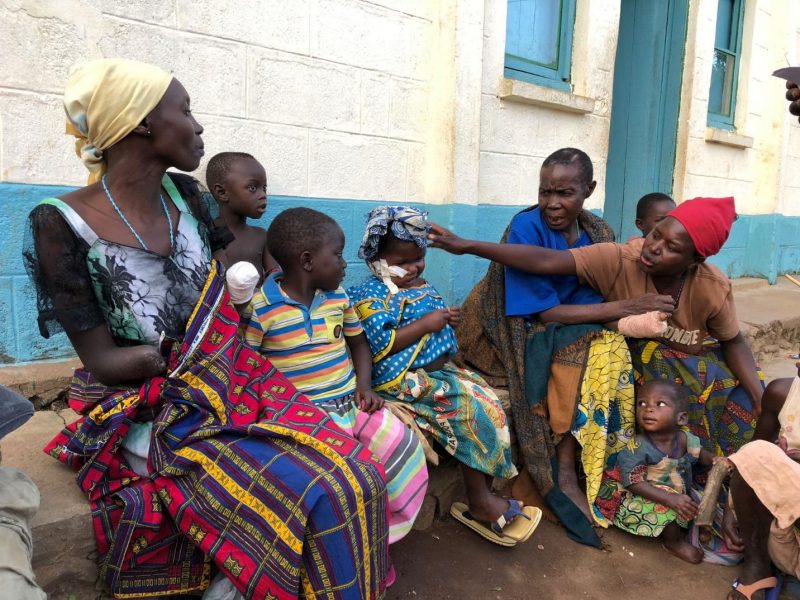
Marie Dz’dza (left), Irene Mave (striped shirt), and Jesinne Dhewedza (blue shirt and bandaged left hand), three generations from the same family, survived a March attack on the village of Logo Takpa near Tche in Ituri Province, Democratic Republic of Congo. Militiamen armed with machetes cut off Dz’dza’s arms below the elbow, Mave’s right arm, and four of Dhewedza’s fingers.
More than 350,000 Iturians were displaced by the violence — including more than 50,000 who fled across Lake Albert to neighboring Uganda. It was as if the entire population of St. Louis, Pittsburgh, or Cincinnati were forced into exile.
What happened in the far east of the Democratic Republic of Congo earlier this year was a slaughter in silence. The wave of massacres was ignored by the world, and the humanitarian crisis that followed was amplified by international neglect. The Trump administration’s “America First” agenda played no small part in this disaster; an abrupt change to U.S. support for peacekeeping efforts in 2017 contributed to the constellation of catastrophes that enabled hundreds of machete-wielding militiamen to kill with impunity and cause immense suffering to hundreds of thousands of women, children and men.
The massacres and the mass exodus from rural Djugu barely registered outside the region. There were no tense debates about it on the United Nations’ General Assembly floor, no stern warnings from the White House, no drumbeat of stories leading the nightly network broadcasts or breathless debate on the 24-hour cable news outlets.
From February to April, I spoke with more than 300 people — including community leaders, current and former government officials, soldiers and high-ranking military officers, activists, analysts, U.N. officials, and aid workers. But the vast majority of my time was spent talking to witnesses and survivors of the violence, like Marie Dz’dza, Jesinne Dhewedza, and Irene Mave. Through my interviews with witnesses and survivors, I corroborated attacks on 31 villages. Community leaders, local journalists, human rights activists, and internally displaced persons (IDPs) provided information on nearly 62 more massacres that fit the pattern of attacks.
Their stories and the destruction that I witnessed in their villages, and the shortfalls in aid that I saw firsthand in DRC and Uganda, showed in vivid detail what happens when the world averts its gaze from a humanitarian catastrophe.
The violence in Logo Takpa was typical of the rolling wave of massacres that emptied Djugu territory. Late one night in March, Lendu men wielding machetes and bows and arrows came screaming out of the darkness into the village. Half-blind and slow of foot, Jesinne Dhewedza couldn’t join her neighbors as they ran. Being a good daughter, Marie Dz’dza didn’t run either. “My mother couldn’t flee, so I had to figure out some way to keep her safe,” she tells me.
A short time later, Dz’dza attempted to sneak out of the village with her mother in tow. It didn’t take long for a group of armed Lendu men to spot them. She knew all of these men. They shared the same marketplace, a collection of wooden stalls along the main road where people bought and sold beans and greens, cassava, and maize flour. She had watched them grow up.
Jesinne Dhewedza, unable to see clearly and size up the situation, scolded the young men. Dz’dza tried to quiet her. “Mama, don’t shout at them. You have to pray for us,” she pleaded. Then one of the men swung his panga and hit Dz’dza in the head, broadside, knocking her unconscious.
Dz’dza woke some time later, her head in a haze, the ground beneath her sticky-wet. Then came the pain. She looked at her arms, the source of her agony. The sleeves of her dress were sliced, hanging by threads and soaked in blood. “I was sure this was the end of my life,” she tells me.
No one came to rescue Dz’dza. She was hardly unique. In rural eastern Congo, you’re mostly on your own. There are no aid groups out in the countryside. There’s no ambulance to call. The police run away from attacks.
She was discovered by soldiers patrolling the village almost two days later, she told me. They drove her to the nearest medical center. “That’s when I realized I had lost them,” Dz’dza says, gesturing toward me with the stumps that remain.
Her dress sleeves were all that had held her lower arms in place.
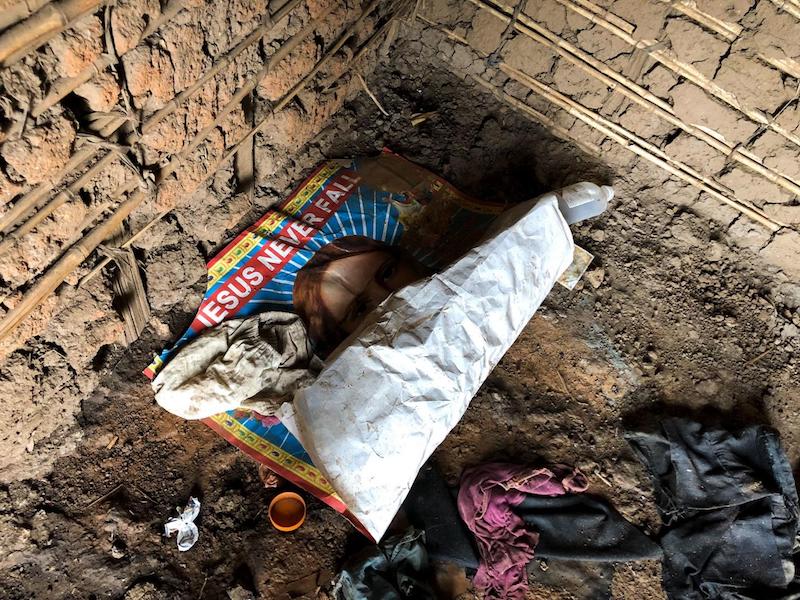
“Jesus Never Fall,” a poster found in the ruins of Tche, Ituri province, Democratic Republic of Congo. In February, machete-wielding militiamen attacked this village, killing men, women, and children, and looting or burning scores of homes.Image: Nick Turse/Investigative Fund
There are no easy explanations for the carnage in Djugu nor for the sudden cessation of massacres in mid-March, although violence — crop destruction, kidnappings, and killings — continues on a lesser scale. Most experts, analysts, and the displaced themselves point to what they call an “invisible hand” — powerful politico-military forces working with local and national power brokers or exiled politicians to drive the Hema community from the region.
Though they lack concrete evidence, many Congolese posit that President Joseph Kabila, whose legal mandate expired two years ago, or his allies, orchestrated the attacks in an effort to destabilize Ituri as a pretext to postpone national elections that are scheduled for this December. Many point to the fact that violence erupted just as Corneille Nangaa, the head of the electoral commission, stated that conflict in Ituri’s Djugu territory could prevent the government from holding polls in 2018. This “strategy of chaos” has been successfully employed before, Ida Sawyer, Central Africa director at Human Rights Watch, told me. “Basically, you create violence in a pocket of the country to such a large degree that it can be used as an excuse for further election delays and another reason for Kabila to hang onto power.” The office of interior minister and deputy prime minister did not respond to multiple requests for comment on this story.)
The motives behind the violence remain murky, but the sheer brutality was clear. Photographs of the dead show heads cleaved almost in half or hacked off completely. Skulls were shattered, genitals amputated. Corpses were so grotesquely mutilated that they disorient the mind. I traveled between hospitals and medical centers and IDP camps, speaking with the injured and the traumatized. I met toddlers whose faces were split by machetes. There was the elderly woman with the shattered arm who had been shot in the face with an arrow. The little girl whose head the attackers tried to hack off. The 11-year-old who lost a hand. The man missing a chunk of his calf, which he said the militiamen tried to force him to eat.
I met several other men who lay in hospital beds, glassy-eyed with fixed expressions, and swaddled in blood-stained bandages,their frames curled up as much as their injuries would allow, as if their entire bodies were wincing. They looked like they expected to be struck at any moment. Many couldn’t manage to speak about what they survived. Women were reportedly gang-raped during the attacks or sexually assaulted while fleeing. Ten percent of Congolese child refugees in Uganda said they were raped during their journey, according to an assessment by Save the Children.
Perhaps worse was the profound neglect of survivors by Congo’s national government and the international community. Clinics and medical centers lacked the drugs to treat patients and even the printed forms needed to transport them to hospitals that might. Refugees found themselves not just homeless but hungry and lacking sufficient supplies of water. Camps for internally displaced persons (IDPs) were short of food. Mothers with young children crammed into overcrowded group tents or slept outdoors for weeks at a time. Those outside the camps fared even worse and were forced to rely on the kindness of family or strangers.
As the sky melts from lilac to plum, Marie Dz’dza tells me her family is just barely getting by with the assistance of the Catholic relief organization Caritas. Jesinne Dhewedza sits almost catatonic most of the time, murmuring just a few words now and again. Irene Mave goes through bouts of silence, too. They all require regular care for their wounds, not to mention the basic necessities of life. Neither is assured.
- "Congo is a place where you see violence all too often, but this spate of violence in Djugu was highly unusual even for Congo’s standards."
Sister Angele, who runs the health center, says her team is doing their best but admits the staff is overwhelmed, with about 9,000 IDPs now living in a camp down the road. “We didn’t expect all these patients at one time. We need basic equipment and supplies — more beds, tables, an X-ray machine, medications,” she says. There are no services. There is no assistance. There is no money. “Don’t even bother mentioning the government,” she says, shaking her head.
“Congo matatizo” is the phrase in Swahili. Congo problems.
Chapter 2: No rescue
Violence of the type that left Marie Dz’dza maimed dates back to the late 19th century, when Belgium’s King Leopold II seized the vast territory surrounding the Congo River — the infamous setting of Joseph Conrad’s “Heart of Darkness.” Leopold’s army looted Congo’s rubber, brutalized its people, and presided over a terror campaign that saw baskets of amputated hands presented to white officers in the service of the king. Murder and famine, disease and displacement took a heavy toll. Congo’s population was cut in half, to just 10 million, during King Leopold’s fin de siècle holocaust.
Millions more would die a century later during what came to be known as Africa’s World War, a conflict that raged from the mid-1990s through the early 2000s. Forty armed groups operated in eastern Congo alone, and more than 5 million people died of direct violence or its fallout — hunger, starvation, illness.
In Ituri, disputes between Hema pastoralists and Lendu farmers became enmeshed in the web of local, national, and regional conflict. By early 2000, months of fighting had left almost 7,000 dead and led to a “humanitarian catastrophe” in Ituri, according to Human Rights Watch. Between 1999 and 2003, an estimated 55,000 people were killed in the province and 500,000 were forced to flee their homes. The region was dubbed the “bloodiest corner” of Congo.
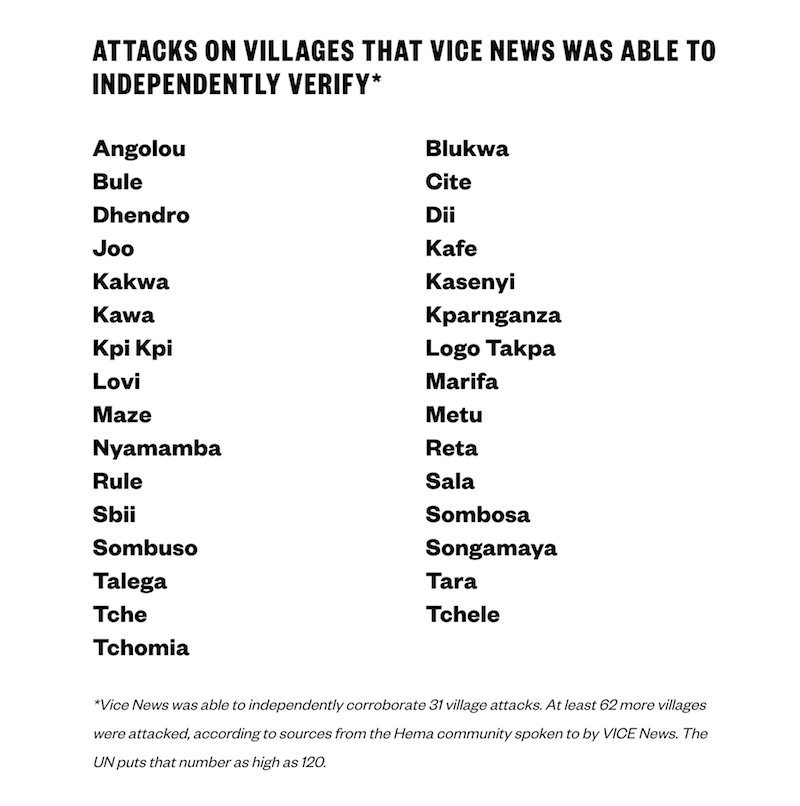
Image: Leslie Xia/Vice News
Today, on a planet awash with conflict and displacement — 68.5 million people worldwide were forcibly displaced by the end of 2017 — the crises in Democratic Republic of Congo still rank among the most profound. There is no shortage of violence and unrest in the provinces of North Kivu, South Kivu, and Tanganyika, in the Kasai region and even the capital, Kinshasa, where anti-government protests have been brutally suppressed.
The 350,000 people who fled Ituri this past spring joined 6.8 million internally displaced Congolese and 552,000 Congolese refugees spread across sub-Saharan Africa. More than 2 million Congolese fled their homes last year alone, close to three times the number of Rohingya made homeless by an ethnic cleansing campaign in Myanmar. In 2018, there were 13 million Congolese in need of urgent humanitarian assistance, the same number as in Syria.
Ituri is no longer the bloodiest corner of Congo, but the violence there in recent months was as severe and merciless as the slaughters at the turn of the 20th century, the 21st century, and almost anytime or anywhere in the world.
“Congo is a place where you see violence all too often, but this spate of violence in Djugu was highly unusual even for Congo’s standards,” HRW’s Sawyer told me. “The violence started with incredible speed and seemed, for many in the region, to come out of nowhere.”
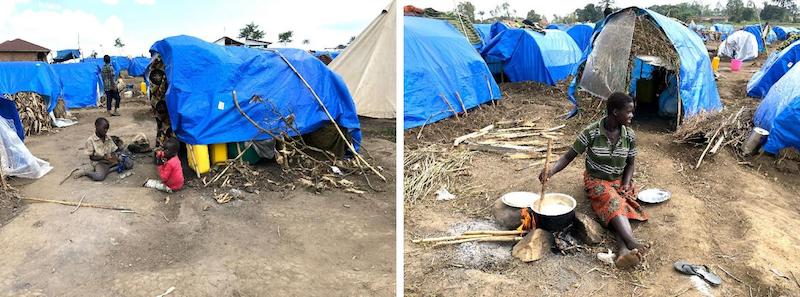
By early April, more than 8,600 people displaced from the Djugu countryside were registered residents of the ISP Camp, in Bunia, the capital of Ituri province.Image: Nick Turse/Investigative Fund
Again and again, Hema refugees and IDPs from Ituri told me even though bad blood may have lingered from past conflicts with the Lendu, both communities had spent the last decade living side by side in relative peace, sharing the same marketplaces and intermarrying. For about six months, tensions rose and rumors of impending violence spread, but they were still shocked when neighbors became murderers overnight.
“This is not an ethnic conflict,” Jean-Marie Ndjaza Linde, the vice-president of the Lendu community’s cultural association, told me in early March, as massacres were still occurring on a daily basis. “This war is not our war. This has been imposed on us by an invisible hand. Ngabu Kaparri Jean-Pierre, a Lendu and a deputy MP in the region from 2006-2011, told me that there might be “a plan to make the two tribes fight.”
The president of the Hema community’s cultural association, Hadji Ruhingwa Bamaraki, said the same. “There is no conflict between the two communities. We don’t understand why we’ve been attacked,” he explained. Bamaraki likewise raised the specter of unseen forces. “Who is behind this? This is well-organized disorder.”
Dozens of witnesses told me they watched local police and soldiers armed with assault rifles run from attackers wielding only machetes and bows and arrows.
- The party most responsible for MONUSCO’s cost-cutting measures? The United States.
Lieutenant Jules Ngongo, the Armed Forces of the Democratic Republic of the Congo (FARDC) spokesman in Ituri, categorically denied these claims. Cowardice, he said, was punishable by 20 years in prison.
But it wasn’t until later in February, when the government deployed soldiers and police from other regions, that the FARDC began carrying out missions targeting the roving bands of attackers in rural Djugu. Even then, according to a United Nations report, Congolese security forces intervened in only 10 of 70 reported attacks in Ituri between February and mid-March.
News of the massacres spread quickly as survivors streamed out of the countryside. It didn’t take long for reports to reach Pierre Claver Bedidjo, a local MP and ethnic Alur from Djugu. Throughout February, he sat at home in Bunia, the provincial capital, agonizing over the situation. Whole villages were burned to the ground, whole families slaughtered — just dozens of miles away — and yet officials in Kinshasa, the governor of Ituri, and the security forces seemed to be doing little or nothing.
Bedidjo had lived through Ituri’s ethnic bloodbath nearly two decades before, and the prospect of another was too much to bear. In a fit of rage, he started typing up letters, an S.O.S. that he hoped would spur the powerful to act. Bedidjo sent each by courier to the offices of officials he believed could save the people of Djugu. His letters were even covered by local media.
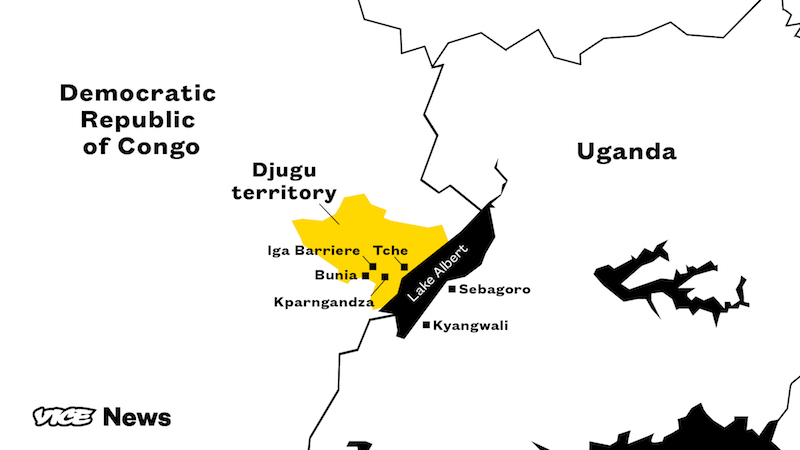
More than 350,000 Iturians were displaced by the violence — including more than 50,000 who fled across Lake Albert to neighboring Uganda.Image: Leslie Xia/Vice News
No one would be able to say that they didn’t know exactly what was happening.
“As the blood runs in the Djugu territory, I see myself obligated to come and seize you. In fact, it’s been exactly a week that your delegation has stayed in Ituri, a bloody week for the population of the Djugu territory,” he wrote in a March 12 missive to Henry Mova Sakanyi, the DRC’s vice prime minister and minister of the interior and security. “In your presence, we registered the attack of more villages, including Sala, Lonyo, Deli, Lutsu, Saikpa, Lodza, Nyamamba, Café, Jina, Loga, etc.” The region was fast becoming a charnel house. “It is time to act and for the public power to impose peace, whatever the price,” he pleaded.
Bedidjo’s fury grew as he punched the keys a day later. “You stayed cloistered for many days in your magnificent air-conditioned office, while outside, the blood ran and ran in a flood,” he chastised Jefferson Abdallah Penembaka, the governor of the province. “You will agree with us, excellence, that there is no time to lose, because each day that passes bring more fires and more deaths,” he concluded. “Do not forget, excellence, that the population of Djugu and of Ituri will judge you for the way that you will protect them during this difficult time.”
(I reached out to Sakanyi and Penembaka multiple times about Bedidjo’s letters, but neither responded.)
- “Just five months into our time here, we’ve already been able to cut over half a billion dollars from the U.N. peacekeeping budget, and we’re only getting started.”
On March 15, fed up by the silence of Congolese officials, Bedidjo appealed to the local head of MONUSCO, the U.N. peacekeeping mission. “As you know, the territory of Djugu is in flames and blood for nearly three months. Killings, the burning of homes, pillaging, and the massive displacement of people, those are the macabre everyday spectacles,” he began. Warning of humanitarian catastrophe and the possibility of famine, he implored the mission to act. “Because, if we are not careful, this territory — perhaps even the entire Ituri province — risks being in flames.”
It’s hard to overstate just how important MONUSCO is to the region, especially given the weaknesses of the Congolese military and local police forces, and how frequently they’re implicated in abuses. A recent study by researchers from the University of Tennessee, Knoxville, and the University of North Carolina, Wilmington, for example, found that MONUSCO bases in Congo dramatically lowered violence in nearby regions. Fewer civilians, they discovered, were killed in areas protected by U.N. troops.
But MONUSCO was hampered by funding cuts in the months before violence broke out and the peacekeeping mission was forced to shutter bases in Ituri.
The party most responsible for MONUSCO’s cost-cutting measures? The United States.
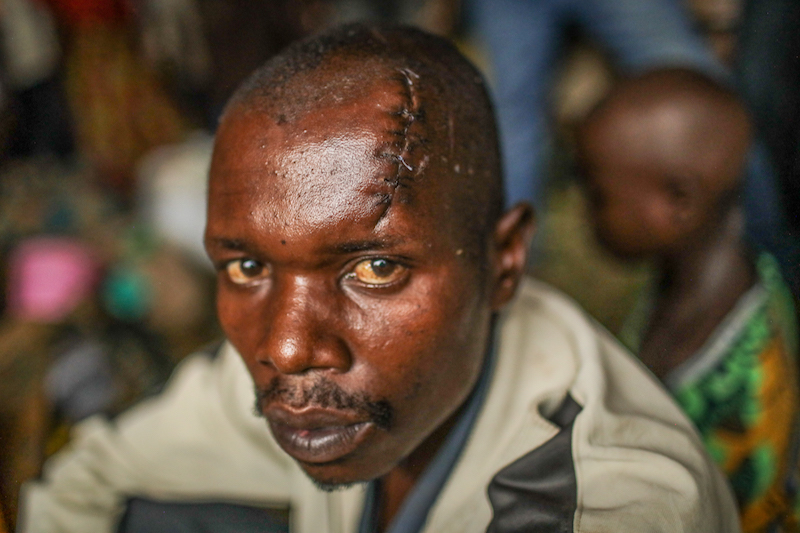
Nyine Richard, 37, fled Tche village with his two daughters, 2-year-old Rochelle and 11-year-old Mave Grace, after his village was attacked by a Lendu militia.Image: Adam Desiderio/Vice News
In 2017, Nikki Haley, President Trump’s new ambassador to the U.N., pushed for and won major reductions in funding for peacekeeping troops, including MONUSCO. Afterward, Haley hailed the cuts as a harbinger of what to expect from the new administration. “We have an obligation to the American people to show value in the use of their taxpayer dollars,” she said. “Just five months into our time here, we’ve already been able to cut over half a billion dollars from the U.N. peacekeeping budget, and we’re only getting started.” VICE News repeatedly reached out to Haley’s office for comment; ultimately a spokesperson said, “We don’t have anything additional to add to her public remarks.”
Long before the effects were felt in Ituri, a 2017 report published by the International Peace Institute warned that Haley’s gambit “tipped perilously toward cost-cutting as an end in itself, rather than reflecting a clear vision for a more effective mission, or a more peaceful DRC.” An even more detailed report by the Center for Civilians in Conflict (CIVIC), published in January, warned there might be “significant gaps in protection for civilians in conflict-affected areas.”
That same month, Ituri exploded in violence.
David Gressly, the U.N.’s deputy special rapporteur for DRC, said slashing the budget with little notice made the 2017 cuts particularly damaging. “It cost us the equivalent of one battalion of peacekeepers,” he said. “We’re forced to cover a larger area with fewer troops, and we’ve also had to pull out of a number of bases.”
- “In areas where MONUSCO has been forced to pull out, armed groups are becoming more active and there are attacks taking place that might have been discouraged by MONUSCO's presence."
The State Department repeatedly failed to answer my questions about whether its cutbacks hampered MONUSCO’s response to the Ituri violence, and instead provided tepid talking points about U.S. support for the mission. MONUSCO, dependent on U.S. aid dollars, largely ignored such questions, although spokesperson Florence Marchal did admit that “the closure of bases affected MONUSCO’s response time earlier this year.”
Lauren Spink, CIVIC’s peacekeeping adviser and the author of the 2018 report, echoed Gressly’s and Marchal’s assessments. “In areas where MONUSCO has been forced to pull out, armed groups are becoming more active and there are attacks taking place that might have been discouraged by MONUSCO’s presence,” she said.
In the wake of the massacres, U.N. peacekeepers set up 12 short-lived “standing combat deployment” bases and five temporary military bases in Djugu. But Spink warned that a “temporary MONUSCO presence in these areas may not be enough to protect communities.”
When it comes to Africa, the MONUSCO budget cuts are part of a larger pattern of neglect by the Trump administration. The president may dispute the report that he referred to African nations as “shithole” countries, but Trump’s policies and funding cuts speak for themselves. On President Trump’s watch, the U.S. has left 14 African nations without an ambassadorship, including the DRC. In August 2017, the administration announced plans to eliminate the position of the U.S. Special Envoy for the Great Lakes Region and the Democratic Republic of the Congo (the duties were folded into another official’s portfolio). Most leadership positions in the State Department’s Bureau of African Affairs are now staffed by personnel in “acting” capacities — placeholders without much authority. The administration even aimed to slash funding for the State Department and the U.S. Agency for International Development (USAID) by about 25 percent.
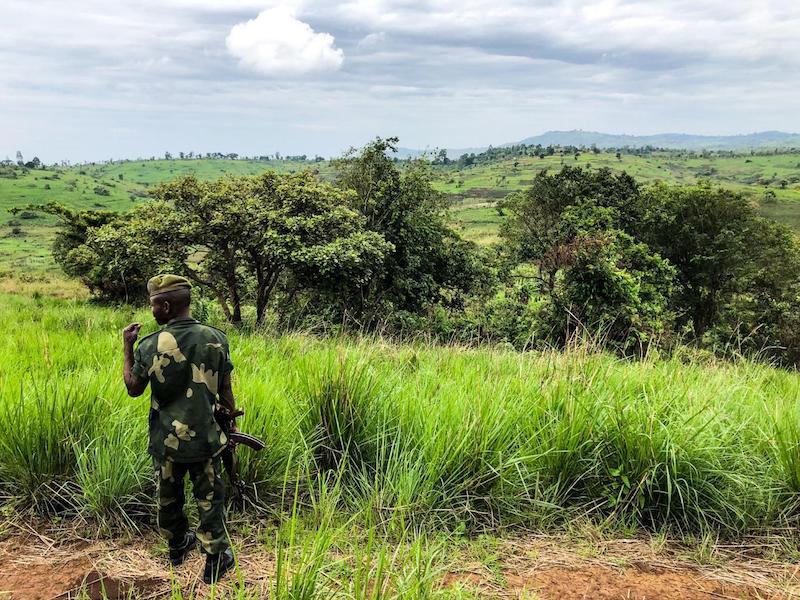
A soldier from the Armed Forces of the Democratic Republic of Congo (FARDC) looks out on countryside in Djugu territory, Ituri province. Image: Nick Turse/Investigative Fund
In DRC, aid dollars tell the story. Ten years ago, when the Humanitarian Response Plan for Congo was funded at 83 percent of the request, the United States was, by far, the top donor. At an April 2018 international fundraising conference, in the wake of the Ituri massacres, the U.S. was only the third most generous contributor, pledging 40 percent less to Congo than it had a decade earlier.
Overall, international humanitarian aid to DRC continues to slip, from $84 per person targeted for assistance in 2015 to $61.50 in 2017. Last year’s appeal for Congo was 59 percent funded, meaning that more than 40 percent of the assistance needed — $331 million — was never donated.
“If you look at last year’s totals, per person targeted, Democratic Republic of Congo received $62. If you look at Syria, it was $305 per person targeted,” explained Kimberly Bennett of the Norwegian Refugee Council, one of the few international aid groups with a conspicuous presence in Ituri during the crisis. “Obviously, costs are different between countries, but how do you explain that disparity?”
By the beginning of this year, inadequate donations meant deepening disaster. Jean-Philippe Chauzy, the head of the U.N. migration agency’s mission to the DRC, announced in January, “The humanitarian situation in the DRC is at a breaking point, as is our capacity to respond.” An estimate of the total need — with a focus on the 2017 trouble spots in the Kasai region, the Kivus, and Tanganyika, but not Ituri — already totaled $1.7 billion.
But the effort to properly fund a humanitarian response in Congo was hampered by Kinshasa’s desperation to project an image of stability to foreign investors and multinational business interests. “The government takes issue with how organizers have characterized the situation in the country in such a way that deliberately tarnishes the country’s image,” presidential adviser Patrick Nkanga said of the fundraising effort. The deputy minister for international cooperation, Freddy Kita, expressed similar sentiments to the New York Times in April, insisting that there was “no humanitarian crisis” in Congo and that calls for assistance were part of a “demonization campaign.”
- "The number of people in need in Congo is the exact same as those in need in Syria. But people don’t care about Congo."
In the end, DRC boycotted its own aid conference in April. Most of the attendees might as well have, too. About $528 million — less than one-third of the estimated need — was pledged by just 22 of the more than 55 countries and regional organizations in attendance. By late last month, the Democratic Republic of Congo held the dubious distinction of being one of the five least–funded humanitarian response plans of 2018, far behind crisis zones like Yemen and Iraq.
“It’s a huge disappointment,” Alexandra Lamarche, an expert on sub-Saharan Africa with Refugees International, an advocacy group based in Washington, D.C., told me. “The number of people in need in Congo is the exact same as those in need in Syria. But people don’t care about Congo,” Lamarche said.
Chapter 3: No Refuge
They came by foot and truck and motorbike desperate and tired, crowding into villages and towns on the edge of Ituri’s sprawling countryside.
In early February, refugees swamped the General Hospital compound in Bunia and spilled into a nearby field that became the town’s first IDP camp. Hundreds of exiles were soon living in makeshift hovels built on top of each other. By late May, 10,722 people shared that postage stamp–sized plot of land.
Humanitarian organizations had outlined a $9 million aid package in February to address Bunia’s needs, but it almost immediately proved insufficient. At the General Hospital, Ignace Bingi, 58, a pastor and an official with the AIDS League of Ituri, a local NGO better known as LASI, said he needed about 1,200 pounds of rice, 660 pounds of beans, and 10.5 gallons of oil per day to provide just one hot meal to each person at the camp. He was constantly on the cusp of running out of food.
“We’re always hungry here,” said Lisinga Gerare, a 57-year-old father of five who fled an attack on the village of Songamaya and now lived in the camp in a tent so small he couldn’t even straighten his legs to sleep.
“You stand in a line all morning to get porridge. All evening, you stand in a line to get rice and beans,” he said. “There’s no meat, no fish, no fufu,” the pan-African staple of cassava dough. “Here, it’s like we’re pretending to live.”
That was in February, when camp residents could still count on eating two meals a day. By April, they were receiving only one — if that. By then, another IDP camp had opened across town and the number of displaced persons registered in Bunia stood at 128,235.
“Tonight, some of them may not get food,” Bingi told me early that month, while standing near the noxious latrines perched on a rise above the camp. “In our stockroom, we’re left mostly with flour.” He had exhausted all funds to pay people to keep the camp clean, to cook food, and to provide security.
“We’re not paying them. God will provide,” he told me, then paused and looked to the sky, before adding, “We hope.”
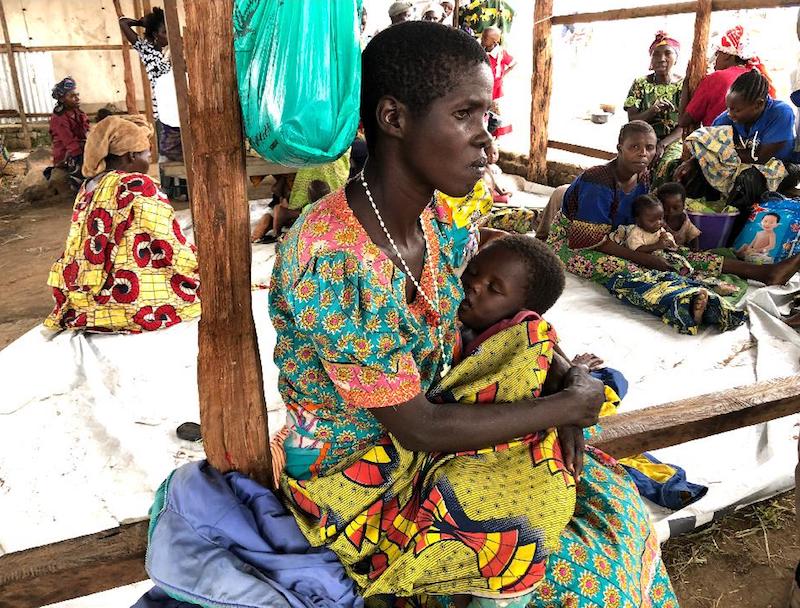
Rogeline Ndrobha, 44, cradles one of her six children inside a rudimentary structure at the ISP Camp in Bunia, the capital of Ituri Province. Ndrobha had spent the previous two weeks sleeping on the ground, in a wooden structure with a metal roof and no walls.Image: Nick Turse/Investigative Fund
Cut off by the roving bands of attackers, many had no choice but to flee east, away from Bunia and across the border that lies in Lake Albert, Africa’s fifth-largest body of water. It cost most people their life savings, or sometimes more — between 10,000 and 40,000 Congolese francs ($6 and $25) — for a voyage in a rickety wooden fishing boat or canoe to Uganda, perhaps the most stable country in the region.
“Boats are overloaded. They become stranded. They lose their way. They run out of fuel,” said Tam Daniel Roger, the UNHCR field officer at Sebagoro, the primary landing site as we spoke one overcast morning in March.
Some never make it. On February 11, four refugees drowned attempting the trip across the lake. A local official, who spoke to me on the condition of anonymity, said that three of the dead were children, ages 3, 9, and 12.
Still, Congolese arrived by the dozens, then the hundreds, then the thousands.
To cope with the influx, international aid workers were redeployed from northern Uganda to the Lake Albert area, where they were already coping with another humanitarian catastrophe in the region, South Sudan’s civil war and the more than 1 million refugees of that conflict. Soon, roadways were teeming with white Toyota Landcruisers sporting the acronyms — UNHCR, MSF, LWF, MTI, AIRD, FRC, IOM, WFP, ICRC — that, together, spell out “crisis-in-progress.” Despite the far larger NGO presence compared to that in the DRC, the new humanitarian emergency taxed the capacity of aid workers to respond.
Then came the outbreak. On February 15, an elderly man was vomiting and suffering fever and acute watery diarrhea when he arrived at Sebagoro. That same day, two children under the age of 5, suffering the same symptoms, died at a refugee camp in Kyangwali. By the end of March, 2,022 cholera cases were reported at Kyangwali and at another refugee camp at Kyaka. An additional 76,000 people at Kyangwali, alone, were soon at risk of contracting the disease.
Overcrowding at Kyangwali’s Kagoma reception center, located 30 miles from Sebagoro — about two hours by road on a dry day — further complicated matters. Thousands were forced to sleep out in the open, exposed to the rainy season’s downpours and “appalling” sanitation conditions.
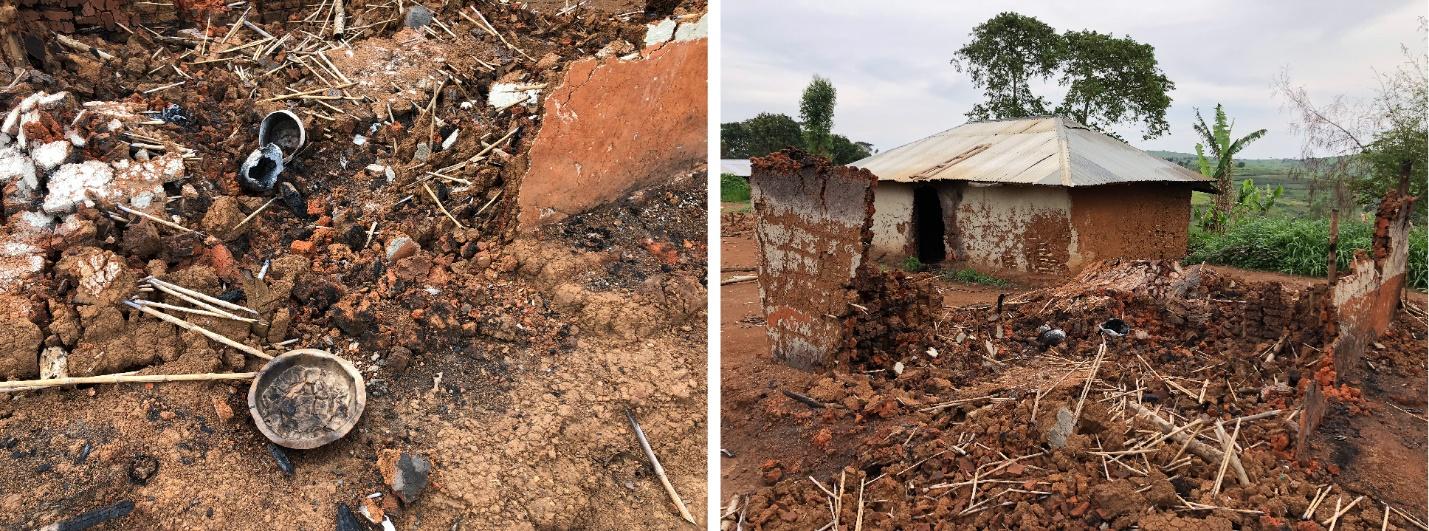
By early April, roving bands of militiamen had laid waste to more than 120 villages in Ituri province in the Democratic Republic of Congo.Image: Nick Turse/Investigative Fund
In February, to cope with the steady stream of refugees arriving on Lake Albert’s shores, officials opened another Kyangwali settlement area, called Maratatu. But for weeks the amount of drinking water available proved insufficient to supply refugees even at emergency levels. In March, a nutrition screening of 1,321 younger children at Maratatu by Medical Teams International (MTI), an Oregon-based international aid organization, found children were malnourished beyond emergency standards.
The rolling grasslands of the sprawling Maratatu settlement appeared dotted with thousands of tiny igloos. At one of these wood, bamboo, and grass huts, covered in white plastic sheets branded with UNHCR’s logo, I met two young orphans, Baraka Locorio and Baraka Losa. Their father had died years ago, and their mother just weeks earlier when their village of Tara was attacked by Lendu militiamen.
“There’s not enough food here. We don’t know when or where the distribution is,” said Locorio. “All we’ve gotten is soap, a jerry can, and the plastic sheet,” explained Baraka Losa, gesturing toward their vinyl-sheathed hovel. “We have enough water,” his brother, Baraka Locorio, told me. “But our biggest challenges are food, clothes, and education. Without these, how can we lead a good life?”
Locorio said he would consider going back to Congo if there was peace. “I’ll go wherever I can to find a future,” he explained. Losa wouldn’t even consider it. “Never! I’ll never go back,” he said. As I spoke with his brother, I noticed Locorio scratching letters, shapes, and symbols onto his arm. He wasn’t breaking the dry skin, but he was using enough force that the etchings remained. I then noticed that his other arm and legs had similar markings. I asked what it meant. “It’s just writing,” he said, frowning at me and looking embarrassed. “I don’t know what else to do.”
- This home was burned, but that one not. This store lay in ruins, but that one still stood.
Chapter 4: No certain future
In April, as people were returning to villages just outside of Bunia, I traveled with FARDC troops down the Central-Largu Road, deep into rural Djugu. The Congolese troops wore camouflage fatigues and a variety of headgear — a bright-red ski cap, a rusted steel pot helmet. They smelled of stale sweat and cigarettes and had spent the last several weeks conducting foot patrols and occasionally, they told me, fighting bands of armed Lendus.
As we bounced along the dirt road, out of the hills and down into grassy flatlands, they pointed to a crossroads with a burned-out car where they said, in late March, they were ambushed by a Lendu force armed with AK-47s and bows and arrows. “We kicked them badly,” said premier sergeant major Nawedji Makobo.
The FARDC deployments and operations by MONUSCO seemingly halted the massacres, but the damage was done. Small groups of men were heading out to farms with army escorts to harvest whatever food they could find, but the villages they returned to were echoes of what they had been, hollow and empty.
The attackers had taken everything worth stealing from the Hema villages — animals and food, kitchen items and clothing. They tore the metal roofs off homes and schools and churches and carried them off. What they didn’t steal, they torched or smashed or scattered about. Many of the homes in these villages were reduced to little ponds of crumbled brick and piles of singed bamboo or survived as life-sized dioramas of destruction, with missing walls that allowed one to peer inside at the detritus of life — a lone rubber boot, broken crockery, a melted plastic jerry can.
The pattern of the violence was stark and offered the clearest indication that ethnic cleansing had been the motive behind the massacres.
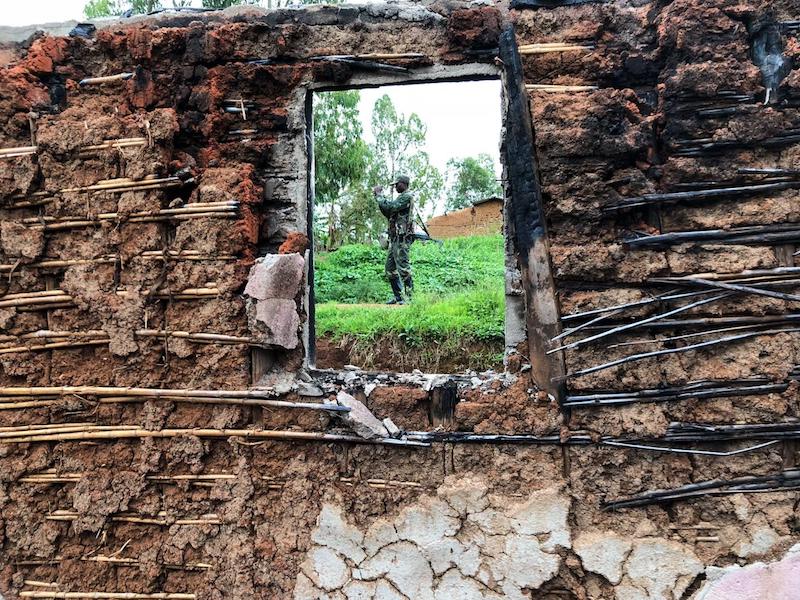
A soldier from the Armed Forces of the Democratic Republic of Congo (FARDC) pauses to take a photo in the ruins of Marifa, one of more than 100 villages in Djugu Territory that were attacked by bands of militiamen earlier this year.Image: Nick Turse/Investigative Fund
The Hema village of Lona, for example, was a collection of ruined homes and deserted market stalls. The Lendu village of Babu, just a short distance down the road, was the picture of rural village life. Tali had been a Hema village; now it was just a point on a map, destroyed and empty of the people who had made it a community. But nearby Saliboko was untouched by flame, and Lendu families there were going about their lives. The Hema village of Marifa was also vacant and dotted with burned buildings, but the neighboring Lendu community of Mosumbuko lived on, unscathed.
A similar logic was apparent in the town of Kparngandza, where Hema and Lendu had lived and worked side by side. This home was burned, but that one not. This store lay in ruins, but that one still stood.
In the weeks after I left Congo in April, Penembaka, the governor of Ituri province, called on the IDPs in Bunia’s camps to return home. He assured them that there were no longer “any concerns.” The Congolese Army’s chief of staff, General Didier Etumba Longila, similarly pronounced that the security situation had returned to normal in Djugu.
Government officials pointed to an agreement signed by leaders of the Hema and Lendu communities in mid-March, which announced a cessation of hostilities, even though both communities insist they weren’t at war. According to anonymous sources who spoke with the U.N., the accord between Hema and Lendu leaders was signed without representatives of the communities even meeting to discuss it.
Low-level violence continues to ripple through Ituri. On April 22, a group of Hema farmers was reportedly abducted by armed Lendus in the village of Kau. On May 8, “a group of men armed with knives made an incursion into Tche” and burned 21 pineapple fields, according to a UNHCR report. On May 24, at a quarry in Djugu, four people were killed and another two injured by machete-wielding assailants. Days later, another three women and one man traveling on a motorbike were kidnapped on their way to Bunia. More recently, reports of sporadic attacks, including murders, lootings, and robberies outside of Bunia, have surfaced, as well as low-level retaliatory attacks between the Hema and Lendu communities and raids by militiamen near Lake Albert.
- “The social cohesion between the Hema and Lendu communities has been completely destroyed."
Civil society organizations, a delegation of Hema and Lendu chiefs, and even senior members of the FARDC, acknowledged that a continuing absence of government troops in some areas of Djugu left refugees afraid to return home.
In late May, even as some IDPs were heading back to their villages, others continued to trickle into Bunia, where life for the displaced had become even more desperate. At the original camp near the General Hospital, they stopped serving meals entirely. Camp managers told local media that it was a “nightmare for most [of the IDPs].”
“Nightmare” was a word I heard more than one refugee use to describe the violence in Ituri or the privation that followed, but few people understood why either had come to pass. Why did neighbors become murderers? Why didn’t the world care that survivors of the violence, some grievously wounded, were going hungry?
“I’m very unsure of what comes next,” Marie Dz’dza told me, wiping her brow with an arm that ended just below the elbow, when I asked her about the future. She was grappling with some particularly difficult quandaries: How would a widow with no formal education, four young children and a disabled elderly mother, support them all? How would a woman whose house was looted and destroyed rebuild her life? How would a person who hails from a rural village where life is challenging for the able-bodied get by in a country where services for the disabled are nonexistent? How would a permanently crippled farmer continue to work the land? How, that is, would Marie Dz’dza survive without arms?
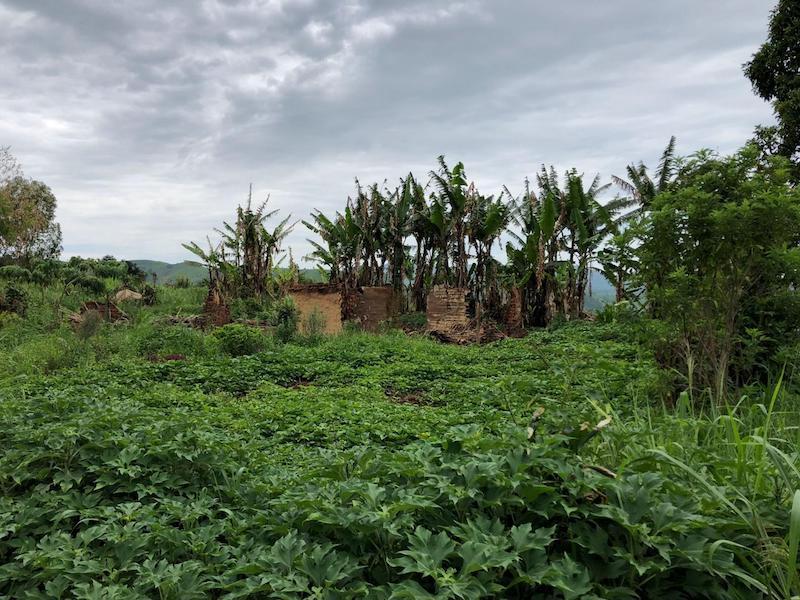
By early April, Djugu territory was filled with the ruins of thousands of houses as well as shells of schools, clinics, and churches.
Image: Nick Turse/Investigative Fund
Her fellow survivors were left with similarly vexing dilemmas. Even if they’re able to return home, it will be to communities without clinics or schools, villages of looted shops, burned houses and fallow fields. Like so many of Congo’s problems, there are few solutions on the horizon. And many believe that the relative calm will give way to further carnage. “The social cohesion between the Hema and Lendu communities has been completely destroyed. The little peace they were able to put together is over,” HRW’s Sawyer told me in June.
In April, when I arrived in Tche, two FARDC soldiers guided me to a cluster of foliage along the main road. They pointed to a crude cross they’d placed there two weeks earlier. It marked, they told me, the final resting place of a man they found while on patrol; a man they found on the spot where I now stood; a man whose head was cleaved almost in half.
Leaving the grave, I walked down the town’s main street — once a thriving center of activity. Now it was a ghost town of charred market stalls and roofless buildings. The cacophony of friends chatting and children laughing had been replaced by birdsong and the rustle of wind through the trees. It was a quiet infused with a peculiar sort of violence, the type of silence that villages at peace never know.
To my left, there was a half-collapsed boucherie and a looted wooden stall with little more than three empty green glass bottles sitting on a shelf. In the corner of another fire-scarred building were a few articles of clothing and a crumpled poster that read “Jesus Never Fall.” Women’s skirts and two mismatched sandals lay inside a half-collapsed home whose door had been torn off. In another, I found a 2009 calendar immortalizing a meeting between then-Pope Benedict XVI and President Kabila, who has been in power since 2001 and has long been accused of exploiting violence to stave off elections. I wondered if it had happened again.
Not long after, I heard something in the distance.It sounded like a brief rattle of gunfire, so I emerged from a ransacked house and caught the eye of one of the soldiers accompanying me. Our languages didn’t overlap, so I pointed to my ear and tried for a look that said, ‘Did you hear that?’
He nodded.
Then he looked away.
This article was reported in partnership with The Investigative Fund at The Nation Institute, now known as Type Investigations.
Fact check by Elena Mejia Lutz and Richard Salame.